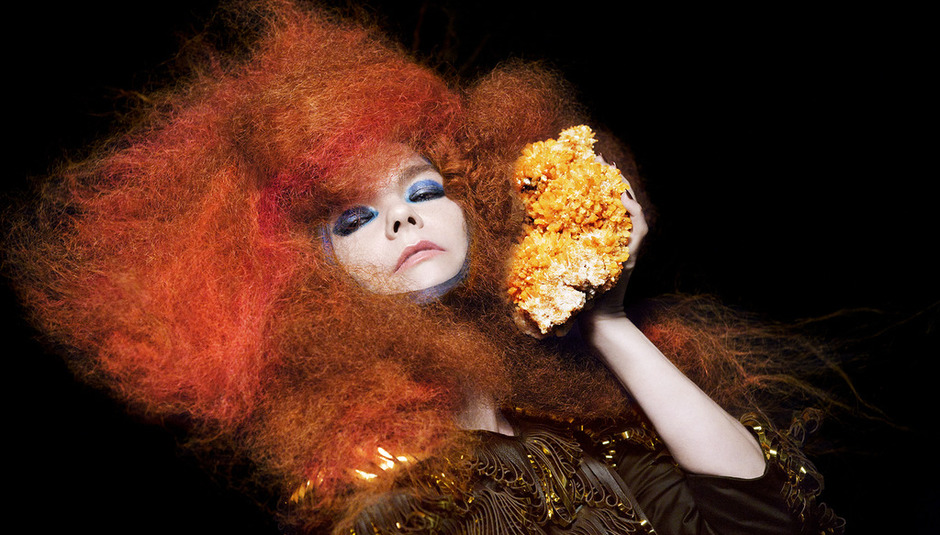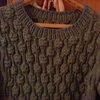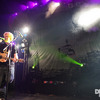Björk's new project Biophilia does not want for ambition. It has been billed as the first 'app album': Each of its ten tracks are being released alongside a corresponding app version for iPad and iPhone. These apps can be bought and accessed through the central Biophilia app, which appears as a galaxy waiting to be explored and navigated, with the songs as stars in its constellation. Zeroing in on a star enables you to hear the song as Björk recorded it, or to play a game which will involve you manipulating the music in some thematically-appropriate way. For example, on ‘Virus’ you play the part of a cell defending itself from viral attack, while on ‘Thunderbolt’ you draw Tesla coil charges which alter the bass lines you hear.
I’d been playing with the apps before we met and while they all seemed intuitive at the time, my notebook ended up covered in a bewildering cobweb of ideas: something about ‘continental drift’, something else about ‘seduction’, something about ‘DNA’, something else about ‘piano keys’. I look at Björk helplessly. Can she put it into words? “In a way, every app is a visualisation of the song. You are inside the song,” she explains eagerly. “I think when you listen to music on headphones and you close your eyes it’s very… internal. I wanted it to be that you could see the sounds, you know?"
Her career has already given us a series of beautiful and intensely original music videos, so I ask whether that experience of working with directors helped to inform her design work with the app developers? One immediate obvious difference is that she's not onscreen for the apps: "With all the video directors I’ve worked with in the past I’ve always had just a couple of clues about each song: ‘This one is about walking on roofs’ or ‘This one is confrontational’ or ‘No, it’s not pink’. I’ll have a few clues about each song, and then I will try and work with them and try and bridge that gap between the image and the sound. But I mean I think this is even better, for me. For me it was never really about the way I look.”
I have to stop her there. This is a woman who wore a swan to the Oscars, whose dress at the Olympics in 2004 unwrapped itself to reveal a 10,000 square foot map of the world, and who, more immediately, is currently sat opposite me beneath a copper dome of hair that blossoms around her ears in the shape of a bell. She’s one of the most iconic pop stars in the world. It must, I suggest, have been a little bit about the way she looked. She laughs. “Yeah, of course it is, but it’s really about the core, and the core of it to me is the song. I guess I learned after being in bands for fifteen years before I did my solo stuff, and we were punks and we were like: ‘Oh, it doesn’t matter how things look it’s all about how they sound’ and then somebody would just take a picture of us and put us in the papers and you would be upset – not that it was ugly, nothing to do with vanity – just that it didn’t fit the music. So I guess I had fifteen years of kinda…” she shrugs indifferently, “and then once every few years I would meet somebody who totally got it. So I learned, almost like I was a pupil. So for fifteen years I learned that if you match the right image to the right sound it makes my life a lot easier! But I think it has changed as I get older and become more idiosyncratic with the music – like, I used to collaborate more but now in the studio I make all the decisions!”
---
You’re an auteur now? “Yeah, yeah, yeah! I’m bossy! I’m a bossy-boots!” She laughs. “Well to be honest it’s mostly me and the engineer so there’s no one to boss around anyway, but I’ve kinda managed to develop more so I know more what I want there, so by the time I work with the visual people, or the app people, or the photographers, it’s like I’m back in a band. It’s like ‘Oh!’ You all sit in a circle and say: ‘How about crystals?’ ‘How about this?’ So it’s more like being in a band. So I enjoy the process, in that way.”
What struck me when I played with the apps was how immersed you become in the music and in the myriad ways that your actions could affect it. In an age where music seems to have been devalued by its sheer ubiquity, these apps demand your full attention. Was that the aim? “Hmm… that’s a good question.” She pauses to think, and when Björk is thinking she does this thing where she rotates her jaw as if chewing distractedly. “To be honest, I wasn’t focused on that but maybe unconsciously! I can’t promise you totally… my focus was kinda more on the fact that we had the touch-screen. We were performing on it on the Volta tour from 2006 to 2008 and all I could see was opportunities. The thing I was more conscious about was how I was unsatisfied with my music education in school. I mean obviously there were a lot of amazing things. I was there for ten years and I loved it, don’t get me wrong, but I felt it wasn’t tactile enough. It was more ‘booksy’ or, I don’t know what you say in English? Like ‘academic’?”
‘Didactic’, I suggest? “Yeah! So because I had such strong feelings about musicology, and about how I see rhythms.” She laughs. “Well, I said it there, didn’t I? How I see rhythms, and how I see different chords and different scales and different speeds, and what I feel like at the beginning of a song, when I go inside and when I come out the other end. I wanted to include that somehow, and I kept thinking: ‘For kids’. I guess because I spent three years on trying to get it as true to how I feel about music as possible, I could say ‘yes’ to your question and say I wanted other people to be able to see it too. But to be honest I wasn’t so much thinking of that because two years into the project I didn’t know that it would come out on touch-screens because they hadn’t even made iPads! I was mostly writing it for our touch-screens, we had Laniers. I was making programs: ‘The structure of this song is crystals, so it’s this shape. Let’s write a program that’s like that.’ Then I’d sing about it and put the emotion in there as well, so for me it was trying to connect things which very often are not connected and I feel they should be, you know?”
---
She's overflowing with excitement about the project now: “In my mind I was trying to simplify something but I guess it comes across as being the most complicated project I’ve ever done! I think it is in print, but I think once you sit down and play with the apps it’s something like… ‘Oh! You go three times round the galaxy and then you tap on something and then lightning comes at you’… it’s very hard to describe in print, because basically then you’re making it didactic again, when you write about it! Basically this project, to cut a really long story short, is about making things that I feel have been too didactic into a 3D tactile experience. You know, you take up the spoon and you get to turn it in circles.” She picks up an empty coffee mug and whisks a tea spoon inside it. “The other idea is to do with electronic music, because I love electronic music. I’ve been doing it for a very long time, but it had its limitations and one of the criticisms I’ve heard for twenty years from people who prefer indie music or classical music or jazz or whatever is that they’ll be like: ‘Yes, but it has no soul’ and I’ve been doing that debate for twenty years now!” She laughs. “It’s like, well, it’s because nobody put it there!”
So this album is not just about bringing together music, technology and nature, it’s also about putting the soul into electronic music? “Yeah, and with the touch screens now you’re not stuck with a grid. That’s why the songs are like they are. The grid is water. The grid is a pendulum. The grid is DNA multiplying. It’s not 4/4. It’s not TCK-CH, TCK-CH, TCK-CH, TCK-CH. It’s basically liberating you from the grid, but it’s still electronic music.”
---
Björk’s quest to give electronic music a soul reminds me of a contrary attempt by Coldplay to use a machine to help their drummer sound less like a machine. In a recent New Yorker article by Burkhard Bilger about a study into time perception by neuroscientist David Eagleman, Coldplay’s Will Champion describes how the band had been using a click track when playing live to keep time but then, having found that playing to it made them sound too rigid, the band decided not to do away with it but to speed it up and slow it down in places to artificially recreate the mood of a live gig. Coldplay now use elaborate “tempo maps” for their live shows and, as Champion told the magazine: “It re-creates the excitement of a track that’s not so rigid.”
As I describe how uncomfortable the idea of Coldplay’s tempo map makes me, Björk is nodding furiously: “Yeah, yeah, yeah, yeah.” It seems strange to me, I tell her, that a machine is actually helping them to sound human. “It’s a really interesting point, because obviously I’ve been doing gigs since Debut and I’ve tried to solve this riddle ten times! It’s like the tenth time I’ve tried to solve this same riddle, in a way, but I just get better tools now! I mean, I personally would not have gone about it that way, because I feel you should let the tools be good at what they are good at. It’s not that the tools are pretending to be human or that the humans are pretending to be tools. Then again, I’m a very different musician to Coldplay. I like extremes. I think they probably like the middle a bit better than I do.”
Björk: queen of the understatement. She smiles. “I’m not saying that as a bad thing, you know? I quite enjoy a fierce techno beat with a pipe organ, do you know what I mean? I like that contrast, you know? Some people don’t. It’s kinda like having carrot soup and tequila, not just chips and sausages.” She laughs. “So I quite enjoy that. I mean the way I’ve done it in the past, what I’ve found really helpful, is if you solve this riddle in a few different ways in each concert, and then you never have songs back-to-back that are solved the same way. That puts the musicians on their toes. Say for example, on the Post tour: I had an accordion player who could play like Beethoven, he was a virtuoso accordion player and he played all the string arrangements but he was playing on a grid… so you had something very human, that no machine could do, and then you had something that only a machine could do. The next song, it would be electronic samples, very techno or whatever, played by a drummer not on a grid. He would be playing that and then I would be singing on top of that, you know?”
---
So varying the use of click-tracks or grids is your way of keeping things fresh? “Yeah. On one song the accordion player would just press ‘play’ on a computer and you’ll have a beat that doesn’t vary in speed. It’s just like a grid. Then you have a virtuoso musician do something that only a human can do. The next song would be a totally different approach, where again you would have electronic sounds that are very electronic – they’re not pretending to be acoustic – but they’d be played by a drummer so they wouldn’t be on a grid, or on a clock, and then you have musicians playing along with that. Then the next song would be just me and a keyboard, and then the next song would be everything on a grid. In that way, things can be dynamic. It keeps people on their toes. I’ve been in bands where nothing is on a grid and that can also, funnily enough, become stagnated. It brings different things out in people if you do that, but I think life is like that, anyway, and nature is like that. You can have something very grid-like such as your calendar, or your heartbeat, but you have to work around it. Aging, for example. It’s not dynamic. You’re not 10, and then you’re 50, and then 5. It’s a grid that you have to work around. You might as well just let it be very ‘griddy’ and then bring something that’s the opposite and... spunk it up!” She collapses into a fit of giggles. “I don’t know what word to use!”
Another example of throwing opposites together is the fact that the electronic sounds the Biophilia apps make are based on a series of acoustic instruments, many of which she had built specifically for this project: “Basically, I kept thinking of the kids. So, I wanted them to have a touch-screen, to have access to an algorithm from nature, to be able to play it with one finger and then for it to be connected with either a pipe-organ, or gamaleste, or pendulum, or sharpsichord. It’s sort of like ‘Where is the electric?’ and ‘Where is the acoustic?’ You make the machine do what the machine is best at doing, which is those algorithms that nobody could do live without it and then you can make impulsive decisions depending on your feelings at the time, or your emotions, and react to that – but then that’s plugged with acoustic sounds. I kept thinking about how kids sometimes get too stuck into computer games and I wanted it to not just be this virtual world where everything’s perfect. I wanted to be connected with things which are more like the skin or oxygen. So basically the pipe-organ is like wind, and the gamaleste is like bronze and the pendulum is like gravity. I just think that age between five and seven is magical. You can learn new languages, you can learn to read and write, you’re just a sponge. So whatever you grasp on the world in those years usually stays with you for the rest of your life.”
Was it important then that there was a element of composition built into the app, as well as creating a new way to present your own music? “Very much so, but I understood that it would just be an introduction. I call it ‘semi-educational’ because if you wanted to take the ‘semi-’ off you’d have to do a lot of work and a proper program. But it’s sort of an introduction, the 101 of musicology, but obviously this is my point of view: how I see musicology, so the songs will sound a little bit like my songs. Hopefully it will inspire people to go off and do their own songs.”
Part 1: Beginnings - Part 2: Biophilia






















